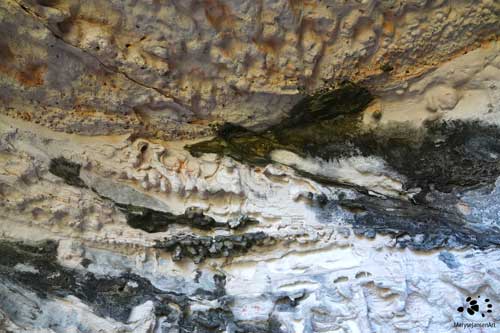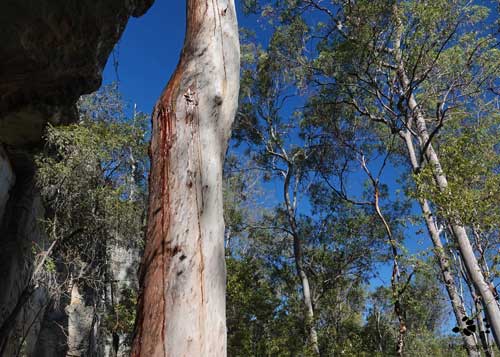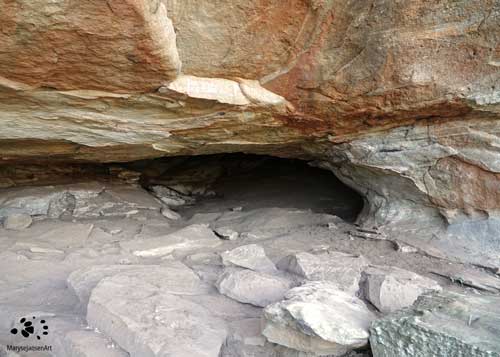Landscape Photography with marysejansenart
The Dragon Cave and the Bloodwood Cave

Table of Contents
The Dragon Cave
Wow! My jaw drops as I gaze up into the Dragon Cave, the first of the two caves in Cania Gorge National Park that I am visiting today. Instantly, it becomes clear how this cave got its name: I am looking at a natural mural on the cave’s back wall and the shape resembles the shape of a dragon quite strikingly! The dragon is black, while the sandstone background comes in shades of white, yellow and brown, so the dragon really stands out! To understand how this cave and its mural were formed we need to go 200 million years back in time!
How was Cania Gorge formed?
In those ancient times, layers and layers of sand that had eroded from distant mountains, were deposited on the plain that this area used to be. Over millions and millions of years, the sediments compressed into layers of sandstone. Around 50 millions years ago, a crack appeared, due to movements of the Earth’s crust. From then on, rainwater began to make it’s way through the crack and started to erode the sandstone. This process continues today still and as a result a deep, wide gorge with cliffs of 60m high has been formed! The original granite rock bed has become exposed and a creek now runs through the gorge which is known by the name Three Moon Creek.
How was the natural mural formed?
Not only water is capable of eroding the soft sandstone, the wind also plays an important part in sculpting this landscape. Together, wind and water are responsible for the forming of the caves. As the sandstone is quite porous, it is not only water that can seep through.
Over the time of millions of years the tannins from the soils and decaying vegetation on the top of the cliff have leeched through the softer parts and flaws in the sandstone. Eventually they have reached this cave, a couple of dozen metres below, and now show on the surface of its ceiling and walls. As a result, I can now look at nature’s artistry in the form of this dragon-shaped mural! Fascinating, isn’t it?!
Bloodwood Trees
The next leg of my walk takes me to the Bloodwood Cave, another captivating name! To understand what the story is here, let me introduce you to the Bloodwood Tree.
Cania Gorge National Park is part of the Brigalow Belt. This is the broad area that runs between the rainforests at the coast and the semi-arid interior of Queensland. The Brigalow is a type of Acacia Tree that used to cover large parts of this area. Today, National Parks protect some of the few Brigalow communities that are still surviving. During my walk I see several types of Acacias (better known in Australia as Wattles), but as I climb higher, the landscape is mainly dominated by Eucalyptus trees.

One type of tree grabs my attention specifically because it looks like it’s bleeding! The resin that is leeching out of its bark has a dark red-brown colour, matching the colour of dried blood exactly. The resemblance in looks with small streams of blood dripping out of a wound is uncanny! Amazing! There are actually several species of Bloodwood Tree in Australia, which are all part of the genus Corymbia, often referred to as eucalyptus. Like the genuses of proper Eucalyptus and Tea Tree, Corymbia is part of the Myrtaceae Family.

Bloodwood Cave
I’m sure this somehow must have to do with the name of the Bloodwood Cave, but when I arrive at the cave it is not instantly clear what the relation is. The cave is very low, not one to walk into. A commando crawl might be more helpful, but I am not willing to try, considering the sharp rocks on the bottom. It is very dark in there, so I can’t actually see how deep the cave is.

What I can see however, is the bark of what looks like thick roots breaking through the sandstone in the left hand corner. These roots belong to a Bloodwood Tree that grows on top of the cliff. They have penetrated through the sandstone all the way down into this cave and are continuing on even further down below. That is how this cave got its name. It might not seem very spectacular but when you take a moment to truly take in how far the roots of this tree are reaching underground through the sandstone that is actually quite awe-inspiring. Not something you normally think about, because it stays hidden from the eye.
Join me on my walk to the two caves and see the roots from the Bloodwood Tree in the Bloodwood Cave and admire the natural mural of the dragon in the Dragon Cave while taking in the breathtaking landscapes of Cania Gorge in the latest episode of ‘Come for a walk in the Australian Bush’:
If you are interested in purchasing a print of ‘Dragon Cave Natural Mural’ or would like to see what the image looks like on the various merchandise products, please head to my shop. If you prefer ‘Bloodwood Tree’, click shop here.


